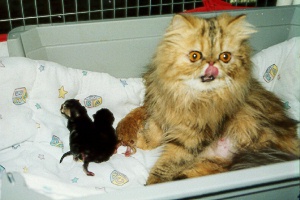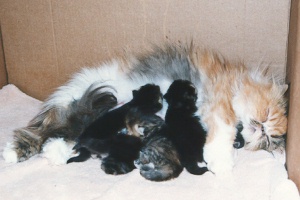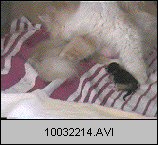Mousekateers
Articles
|
|
| Pray for an uneventful labor but have your veterinarian on standby just in case your queen needs an emergent C-section. | Persian kittens have very large heads that often get stuck, necessitating surgical intervention, not only to save the lives of the precious little kittens, but of the queen. |
 |
 |
|
|
|

A-5 clippers to clip the fur around the nipples, Betadine solution, a bulb syringe, sterile hemostats, and sterile scissors are a few of the items you may need in order to assist your queen in delivering kittens. |
 |
The queen's claws
should be clipped at least 24 hours before delivery so she does not accidentally
scratch the newborns. I find that queens often knead while nursing their
babies, even while lying on their sides, and not only can they scratch
a newborn, but they can pull any loose bedding up over the kittens. This
can be dangerous for the kittens since they can get buried in the bedding
and be unable to get to the mother to nurse. This has happened so frequently
that I no longer use baby blankets (as shown above) inside of a plastic
(drawer-sized) storage container or the bottom portion of a cat carrier
( but I actually pin down the baby blanket to the wire of the cage after
the babies are born. This can be a hassle since the bedding needs to be
changed daily, but it's given me peace of mind to know that I won't discover
a "buried" kitten.
Ideal supplies to
have on hand to assist in delivery of kittens:
- Sterile gloves
- An ear-bulb syringe (like they use in human nurseries to clear mucus from the nose, or some computers come with them for blowing dust off delicate internal parts)
- Betadine (to use on the cord after it's severed and clamped-off)
- Sterile hemostats (or use can hold pressure on the cord with your thumb and index fingers until the bleeding jhas stopped)
- Sterile scissors (to cut the cord if the queen does not)
- Sterile gauze (use this between your fingers and the cord when applying pressure to the cord, otherwise it will be slippery with your gloves on)
- Clean, dry cotton rags (cut-up cloth cotton diapers work well for this)
- Large towels, layered, and remove one each time a new kitten is born and the bedding gets wet (so that the just born kittens won't lay on a wet bed and get chilled)
- A clean bowl (to fill with warm water in case a kitten needs rapid warming)
- A hair dryer (used very carefully on medium heat, if necessary, to dry a wet-chilled kitten)
- A warm water bottle (with a towel over it to place in the kittening box so that all the kittens will be kept warm while the queen is busy delivering more)
- Oxytocin and a sterile TB syringes (you should only need one, but in case you contaminate the needle, you should have an extra one available)
I focus on the kitten's airway. I want that kitten out of that sac as soon as it is born and the airway cleared of all that thick, slippery, mucous-like material. If this is not done quickly, the kitten will aspirate fluid into its lungs, be deprived of oxygen, and suffer brain damage or a number of other complications, or develop aspiration pneumonia and die later from it. A kitten in trouble will gasp for air, or breathe using its accessory respiratory muscles causing chest retraction as it breathes. To prevent this you must rip the sac open over the kitten's head, wipe it dry with the gauze or a freshly washed soft cotton rag, and use the bulb syringe to suction the mucous out of its nostrils. You can do this without upsetting the queen because she can still be licking the kitten's body, or eating the placenta. Another way to get the job done efficiently is to hold the kitten's face and head upside down (so that any fluid drains out of the nose and mouth instead of down into the lungs) in front of the queen's mouth so that she will focus licking the kitten's face. Her tongue is very rough and this is good for licking off the slippery stuff, and at the same time stimulating the kitten to breath.
Once the airway is clear, focus on stimulating the kitten by encouraging the queen to lick it, or by rubbing it with a dry, soft cotton rag. A lethargic kitten is in trouble. Stimulate it so it will breath.
Next, you can hold
the placenta above the kitten so that all the blood drains down from the
placenta into the kitten. Placenta's are full of blood and the kitten can
always use a little more. There is really no big hurry to cut the cord,
five or ten minutes after the birth is fine. As long as the kitten is being
kept warm.
To assist the queen
in severing the cord, hold the kitten with one hand, and the placenta with
another (always above the kitten) and position the cord near the queen's
mouth. She will probably sever it herself with her teeth. If she doesn't,
then clamp it with the hemostats (if you don't have hemostats, then put
pressure on the cord with a gauze over it, by holding it between your thumb
and forefinger) and cut it with the sterile scissors above the clamped-off
area (not below). Leave the clamp there for a minute or two to make sure
that the umbilical artery won't bleed or re-bleed. A kitten can bleed to
death quite quickly if hemostasis is not achieved since the umbilical artery
is a very large artery. If the queen wants to eat the placenta, let her,
but don't let her eat all of them because ingesting all that blood will
give her diarrhea. The next focus is
on keeping the kitten warm. The best way to do this is to:
- Dry the kitten as thoroughly as possible, use the hair dryer (on low or medium heat) if you have to
- Keep the bedding dry
- Keep the room warm, make sure there are no drafts (I use baby crib bumpers around the inside of my cages for this purpose)
- Place the kitten on the mother's belly
- Cover the kitten or kittens if she's busy delivering another kitten
- Place them on a water bottle filled with warm (not hot) water that has been covered with a towel
- Have a lamp with a light bulb over the nest (make sure the wattage is correct for the type of lamp)
- Do not place the kittens on a heating pad, I've found that the pad gets too hot and the mother often refuses to lay on it because she gets too hot (remember she's been working hard at labor),
- Most importantly, keep the queen's nest in a kittening cage so that she's confined with her newborn kittens. Have her food, water, and litter in the cage with her. Otherwise she may move her kittens to a place that's too cold, or she may not be attentive to them. This bonding period can make the difference between survival and death for your kittens.
I hope that this was helpful to you. Please make sure you can recognize when you need to call your vet and read all the articles and books that you can get your hands on before breeding Persians. This breed of cat probably has the most problems with delivering kittens because not only are their heads very large and often get stuck, their nasal passages are smaller then those of other breeds because of their brachycephalic skulls. Can you think of a more challenging cat to breed?
 Honey
licking her first born kitten. Honey
licking her first born kitten. |
 |
 Honey
trying to push out her second born. Honey
trying to push out her second born. |
 She's
doing a good job keeping them warm. She's
doing a good job keeping them warm. |
 She's
exhausted and her kittens are nestled together trying to keep warm. She's
exhausted and her kittens are nestled together trying to keep warm. |
|
Angela Bassett Benny Billi Cameron Diaz Chipmunk Christina Ricci Halle Berry Honey Jennifer Lopez Lassie Cheyenne Laurel Lindsay Lohen Peggy Sue Reba McIntire Tyra Banks Vanessa Williams Wooly Bully |

Want to listen to some music? Just point and click. It takes a second to load, so please be patient. Music
|

